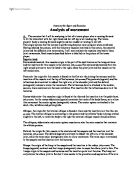Anatomy and physiology
Scott Barnes
A)Protection :- This where the skeleton is used to protect vital organs. The ribs are used in this to protect the lungs and heart and they are attached to the thick bone called the sternum. The pelvis is also used to protect the reproductive organs.
Movement :- The skeleton is used to move the whole body anywhere. Every bone in the body is used for movement but the most important ones are the vertebrae, femur, tibia, fibula (legs) humorous, ulna and radius (arms).
Storage :- Bones store calcium which is needed to live and it is a core component of bone. It is stored in the centre of the bone and is used to replace dead and damaged bone.
Attachment for muscles :- the body cannot move without the help of muscles and so the muscles are attached to the bone and grow with the bone. They also allow the body to do complex movements like bending and give the body flexibility.
Production of red blood cells :- Bones help the production of blood cells and also provide a pathway for them to travel.
The skeleton is divided into 2 sections which are the axial skeleton which is the skull, ribs, vertebral column and sternum these are used to protect vital organs.
The second section is the appendicular skeleton. This allows movement it features the hips, shoulder, arms, hands, legs and feet. There are many types of movement like flexion and extension (in the arms, feet, knee and others), Abduction and adduction (in the shoulders, hands,).
Scott Barnes
A)Protection :- This where the skeleton is used to protect vital organs. The ribs are used in this to protect the lungs and heart and they are attached to the thick bone called the sternum. The pelvis is also used to protect the reproductive organs.
Movement :- The skeleton is used to move the whole body anywhere. Every bone in the body is used for movement but the most important ones are the vertebrae, femur, tibia, fibula (legs) humorous, ulna and radius (arms).
Storage :- Bones store calcium which is needed to live and it is a core component of bone. It is stored in the centre of the bone and is used to replace dead and damaged bone.
Attachment for muscles :- the body cannot move without the help of muscles and so the muscles are attached to the bone and grow with the bone. They also allow the body to do complex movements like bending and give the body flexibility.
Production of red blood cells :- Bones help the production of blood cells and also provide a pathway for them to travel.
The skeleton is divided into 2 sections which are the axial skeleton which is the skull, ribs, vertebral column and sternum these are used to protect vital organs.
The second section is the appendicular skeleton. This allows movement it features the hips, shoulder, arms, hands, legs and feet. There are many types of movement like flexion and extension (in the arms, feet, knee and others), Abduction and adduction (in the shoulders, hands,).






